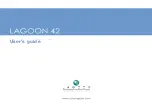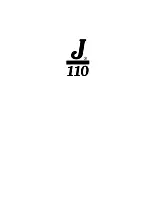
Gemini 105Mc Owner’s Manual
22
Copyright © 2004 Performance Cruising Inc.
Mast Rigging
Mast and Rigging
The Gemini 105Mc mast is 39’ off the deck and the
bridge clearance is 46’
The mast is deck stepped and sits on the main bulk-
head. The main bulkhead is 3/4" teak ply, increased
to 2 ¼” thick under the mast.
The mast is a double spreader rig with the shrouds
coming down to the main bulkhead. The chain plates
are slotted through the deck and bolted to the main
bulkhead. There are steel straps that transmit the
load down to the bridge-deck.
The slotting of the chain plates through the deck is
the strongest system but requires periodic mainte-
nance. As the chain plates take load and stretch, the
seal can break. There is a stainless cap that is loaded
with silicone sealant. Simply re-caulking the chain
plate will solve any leak problems.
Like most modern sailboats, the Gemini’s mast is
relatively light to reduce pitching and improve per-
formance. When a light section is used it is necessary
to use double or triple spreaders. Most race boats
will use running backstays to keep the mast straight.
With Gemini, in place of running backstays there are
permanently mounted check stays and a baby stay to
the lower spreaders
The cap and lower shrouds are 7mm (9/32”). The
intermediate, baby, check, and back stays are 6mm
(7/16”). The 7mm stays use a 1/2” turnbuckle while
the 6mm stays use a 7/16” turnbuckle.
The backstay is a single 6mm stay (33.36’ from cen-
ter pin to Delta plate), with a 15 foot 7/32” bridle
going to each transom. The tensioning device slides
down the lower bridle pulling the bridles together,
tensioning the backstay.
Tensioning the backstay tensions the headstay which
is needed for windward work.
Caution: Leaving the backstay under permanent ten-
sion would damage the boat. Slack off the backstay
when not in use for upwind work.
Tensioning the Rigging
If the Gemini 105Mc is commissioned at the Perform-
ance Cruising factory, all the rigging is tensioned
before handover and should not need adjustment
until such time as the tension has been altered
through extended use. Typically, the rigging tension
should be checked as part of the 6 month mainte-
nance schedule.
We recommend the use of a tensioning gauge for
adjustments to the rigging. Both sets of cap, inter-
mediate, and bottom stays are initially tightened by
checking the number of threads visible at the base of
each stay. Following initial tightening, the following
details, in order, the tensioning on each of the stays.
It is important to adjust the stays in order:
* The back stay should be tightened to the point
where all slack is eliminated but with no bow or
bend in the mast. The check stays are present only
to eliminate mast pumping and are tightened to the
point where there is just a small amount of slack.
The baby stay should be tight enough to put a small
pre-bend in the mast so that when the Genoa pulls
forward in heavy wind, the mast straightens up.
The halyards are low stretch ropes with shackles.
The rope is 3/8" or 7/16". The halyards are internal
for the main, jib and topping lift.
There is provision for a second internal jib halyard
and a crane for an external spinnaker halyard. To
use a spinnaker there needs to be a lower halyard to
support the spinnaker pole, and a pad eye to fix the
spinnaker to the mast approximately 2' up from the
base.
The masts are delivered with a combination anchor \
tricolor light on the top of the mast, a steaming light
2/3 of the way up the mast, a deck light 2/3 of the
way up the mast, coax for a VHF antenna and an
aluminum tube in the mast with a feeder line to pull
through the wires for the mast head instruments.
The masthead unit of the wind instruments is drilled
and tapped to the top plate, facing forward.
On the side of the mast at the base are pads at the
right angle and position for bolting on two single
speed winches, one for main and the other for the
jib.
The gooseneck is riveted to the mast 24" up, with
hooks on either side for slab reefing.
When setting up the rigging, the most important
point is for the mast to be straight with all the side
shrouds set to the same tension. Beside a tension
gauge, the best way to test for equal tension is to
pull the shroud 6' up. With about 40 lbs. of pull the
Stays
(In order of
tensioning)
Tension in
Kilograms
Tension in
Pounds
Back Stays (6mm)
*
*
Cap/Top Stays
(7mm)
440
970
Intermediate Stays
(6mm)
320
705.2
Lower Stays (7mm)
440
970
Baby Stay (6mm)
*
*
Check Stays (6mm)
*
*
















































